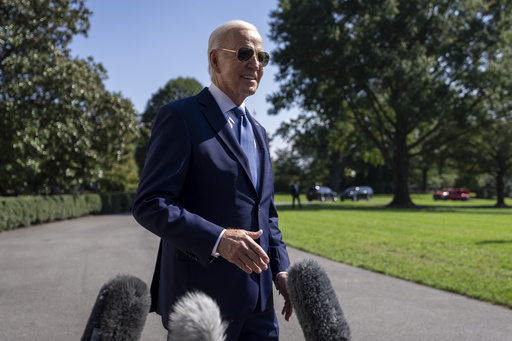
As Election Day approaches, Kamala Harris, the Democratic candidate, is working diligently to sustain a broad coalition of voters who were mobilized four years prior by their strong opposition to Republican Donald Trump and the anxieties surrounding a devastating pandemic.
The former president is focusing on further solidifying his support among demographics such as men without college degrees, a group where he has already found significant backing, while simultaneously seeking to diminish Harris’s appeal among Hispanic Americans and other significant voter segments.
The extensive AP VoteCast survey from the previous election reveals insights into Joe Biden’s decisive victory and Trump’s loss in 2020, while also hinting at what these outcomes might indicate for the upcoming 2024 election.
The real determinants of whether candidates will manage to broaden their support bases or forge entirely new alliances will unfold upon the release of the 2024 VoteCast results on Election Day.
Biden’s win four years ago was significant, yet not overwhelmingly so, presenting a challenge for Harris—she must either maintain his extensive support or construct a unique coalition capable of securing victory.
The previous VoteCast findings highlighted that Biden commanded considerable majorities among college graduates, women, and younger voters, securing large portions of urban as well as suburban populations.
He garnered the backing of approximately 75% of non-white voters, which included a striking 90% of Black voters and around 60% of Hispanic voters.
In addition to these groups traditionally aligned with Democrats, Biden also made inroads with moderate voters and reduced Trump’s support among white women and younger white voters.
Unlike Biden, Harris has channeled enthusiasm for her campaign through large-scale rallies and has recognized the diverse makeup of her coalition via targeted Zoom gatherings aimed at demographic-specific groups such as “Black Women for Harris,” “Black Men for Harris,” and “Latinas for Harris,” in addition to other creative community-focused initiatives.
She has made concerted efforts to connect with women through notable conversations like a sit-down with Oprah Winfrey, and she has engaged in discussions on popular podcasts such as “Call Her Daddy.”
Her outreach extends to labor unions vital for voter turnout in swing states, and as a graduate of Howard University, she is leveraging ties with historically Black colleges, universities, fraternities, and sororities.
Trump, on his end, successfully retained the loyalty of white voters without a college education, rural communities, and religious conservatives during the last election cycle.
Despite losing the popular vote, he remained competitive due to these significant demographics, securing the support of approximately 55% of the 75% of U.S. voters who identified as white.
Additionally, he won over around 80% of white evangelical Christian voters and 60% of those residing in small towns and rural areas, along with a substantial backing from white voters lacking college degrees.
Although this coalition was insufficient in securing a presidential victory for him in 2020, it is substantial enough for Trump to remain competitive in his upcoming campaign.
In 2020, white voters without college degrees accounted for about 43% of the voter base, and Trump has built on this foundation through extensive outdoor rallies and active social media engagement this year.
He has also reached out through popular podcasts among younger men and attracted the interest of significant tech figures like Elon Musk, who co-headlined a recent rally in Pennsylvania.
Trump’s strategies now include engaging with Black and Hispanic voters in his speeches, while promoting entrepreneurial ventures, including a cryptocurrency initiative and selling various merchandise such as sneakers and wristwatches.
Nonetheless, the 2020 election unfolded under different societal circumstances, with the COVID-19 pandemic being the primary concern for voters at that time.
Back then, nearly 40% of the electorate cited the pandemic as their top issue, with around 75% of them supporting Biden.
The transition in concerns may offer advantages to Trump, but it does not assure success.
Current focal points for voters seem to encompass inflation, immigration, and abortion.
Previously, about half of the electorate expressed belief in Trump’s superior ability to manage the economy compared to Biden, who was regarded favorably by 40%.
Current sentiments indicate that opinions on economic issues might increasingly align with individuals’ political views, prompting Harris to concentrate on initiatives intended to help middle-class families manage escalating costs.
The previous election also acted as a referendum on Trump, who was the incumbent at that time.
While approximately 60% of voters indicated their choice stemmed mainly from a preference for their candidate, about 40% cited their vote as largely a rejection of the opposition.
Harris has attempted to position herself as a candidate representing change, contrasting with Trump, who is also campaigning on a platform of transformation by breaking away from Biden’s policies.
Many voters have expressed a desire for change and initially felt discontent regarding a potential Biden-Trump rematch.
However, this concern was somewhat alleviated when Biden exited the race after a challenging debate against Trump.
A recent poll revealed that 58% of U.S. adults expressed dissatisfaction should Trump lead the Republican ticket, while 56% would feel similarly if Biden were to be the Democratic nominee.
The increasing appetite for change is reflected in a surge of enthusiasm among Democrats for Harris as opposed to Biden, as recent polling indicated a preference for the notion that Harris “would change the country for the better” compared to Trump.
